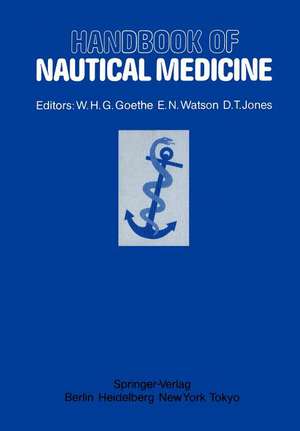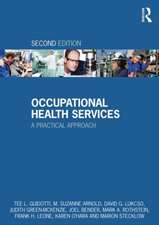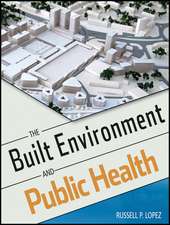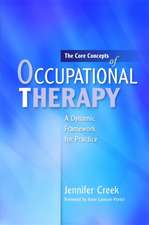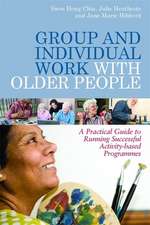Handbook of Nautical Medicine
Editat de W. H. G. Goethe, E. N. Watson, D. T. Jonesen Limba Engleză Paperback – 6 dec 2011
Preț: 732.01 lei
Preț vechi: 770.53 lei
-5% Nou
Puncte Express: 1098
Preț estimativ în valută:
140.07€ • 146.64$ • 115.90£
140.07€ • 146.64$ • 115.90£
Carte tipărită la comandă
Livrare economică 05-19 aprilie
Preluare comenzi: 021 569.72.76
Specificații
ISBN-13: 9783642694172
ISBN-10: 3642694179
Pagini: 520
Ilustrații: XXVI, 490 p.
Dimensiuni: 170 x 244 x 27 mm
Greutate: 0.82 kg
Ediția:Softcover reprint of the original 1st ed. 1984
Editura: Springer Berlin, Heidelberg
Colecția Springer
Locul publicării:Berlin, Heidelberg, Germany
ISBN-10: 3642694179
Pagini: 520
Ilustrații: XXVI, 490 p.
Dimensiuni: 170 x 244 x 27 mm
Greutate: 0.82 kg
Ediția:Softcover reprint of the original 1st ed. 1984
Editura: Springer Berlin, Heidelberg
Colecția Springer
Locul publicării:Berlin, Heidelberg, Germany
Public țintă
ResearchDescriere
International cooperation on the health of seafarers began many years ago. As early as 1921, an international convention regarding this matter was presented to govern ments of maritime countries for ratification. The First World Health Assembly, in 1948, recommended that WHO should establish, with the International Labour Of fice, a Joint Committee on the hygiene of seafarers. The first session of this Com mittee, held in 1949, defined the problems affecting the health of seamen and made a number of recommendations. In the opinion of this Joint Committee, the health of seamen called for interna tional attention for a nu mb er of reasons. By the nature of his work, the seafarer is obliged to travel from country to country and is exposed to great variations of cli mate and also to any disease that may be prevalent in the port of call. He may there fore become a carrier of disease, so that the protection of his health is of importance not only to himself and the other members of the crew but also to the populations of other countries he visits. Yet, on account ofthe nature ofhis employment, it is diffi cult to provide the seafarer with the same standard of health care that is gene rally available to other sections of the population.
Cuprins
1 Introduction to Nautical Medicine.- 1.1 The History of Nautical Medicine.- 1.1.1 A Medical View of the Development of Shipbuilding and.- Navigation.- 1.1.2 Hygiene.- 1.1.2.1 Diet.- 1.1.2.2 Water Supply.- 1.1.2.3 Ventilation.- 1.1.2.4 Cleanliness, Heating and Lighting.- 1.1.2.5 Clothing.- 1.1.3 Quarantine.- 1.1.4 Diseases at Sea.- 1.1.4.1 Scurvy.- 1.1.4.2 Tropical Diseases.- 1.1.4.3 Other Diseases.- 1.1.4.4 Seasickness (Kinetosis).- 1.1.4.5 Venereal Diseases.- References.- 1.2 The Ship’s Doctor, Yesterday and Today.- 1.2.1 Greek and Roman Age.- 1.2.2 The Middle Ages and Venice.- 1.2.3 The Age of the Explorers.- 1.2.4 French Naval Medicine.- 1.2.5 British Naval Medicine.- 1.2.6 The Ship’s Doctor, the Pharmacist and the Medicine Chest.- 1.2.7 Medical Guides and Famous Ship’s Doctors.- 1.2.8 The Ship’s Doctor in Recent Decades and Nowadays.- References.- 1.3 The Ship’s Medical Centre and Medicine Chest.- 1.3.1 Shipbuilding.- 1.3.2 Number of Crew.- 1.3.3 Vessels Engaged in Deep Sea Voyages.- 1.3.3.1 Passenger Vessels.- 1.3.4 Doctor on Board.- 1.3.4.1 Cruise Ships.- 1.3.4.2 Cargo Ships.- 1.3.5 The Ship’s Medicine Chest.- 1.3.5.1 Ships Carrying Dangerous Cargo.- 1.3.5.2 High-Risk Vessels.- 1.3.5.3 Fishing Vessels.- 1.3.5.4 Vessels Solely Engaged in Coastal Regions.- 1.3.5.5 Vessels in Deep Sea Voyages.- 1.3.5.6 Accidents (see also Chapt. 3.2).- 1.3.5.7 Common Cold.- 1.3.5.8 Gonorrhoea and Other Venereal Diseases.- 1.3.5.9 Skin Diseases.- 1.3.5.10 Dental Complaints.- 1.3.5.11 Stomach and Intestinal Complaints.- 1.3.5.12 Diseases of Muscles and Joints.- 1.3.5.13 Eye Trouble.- 1.3.5.14 Kidney and Bladder Complaints.- 1.3.5.15 Mycosis.- 1.3.5.16 Ear Trouble.- 1.3.5.17 Burns.- 1.3.5.18 Lice, Pediculosis.- 1.3.5.19 Constipation.- 1.3.5.20 Haemorrhoids.- 1.3.5.21 Nervous Complaints.- 1.3.5.22 Scabies.- 1.3.5.23 Kinetosis (Seasickness).- 1.3.5.24 Psychosis/Alcoholism (see also 1.3.5.21).- 1.3.5.25 Abscesses.- 1.3.5.26 Hepatitis.- 1.3.5.27 Diabetes.- 1.3.5.28 Miscarriage.- 1.3.5.29 Epilepsy.- 1.3.5.30 Asthma.- 1.3.6 Other Medical Supplies.- 1.3.6.1 Medicines for Diseases of the Heart and Cardiovascular System.- 1.3.6.2 Analgesics.- 1.3.6.3 Antibiotics.- 1.3.6.4 Cortisone.- 1.3.6.5 Infusions.- 1.3.6.6 Disinfectant.- 1.3.6.7 Injection Syringes and Needles.- 1.3.7 Control of Medical Chest.- 1.3.8 Definition of Medicaments.- 1.3.9 Training.- 1.3.9.1 Doctor on Board (see also Chapt. 1.2).- 1.3.9.2 No Doctor on Board (see also Chapt 1 4).- 1.3.10 Medical Locker.- 1.3.11 Radio Advice (see also Chapt. 1.4).- 1.3.12 Conclusion.- References.- 1.4 Medical Care on Ships Without a Doctor — Radio Medical Advice.- 1.4.1 Health Situation on Board.- 1.4.2 Who Performs Medical Treatment on Board?.- 1.4.3 Medical Education of Shipboard Personnel.- 1.4.4 Radio Medical Advice.- 1.4.4.1 The Ship’s Side — Medical Emergencies on Board.- 1.4.4.2 The Shoreside — Who Gives Radio Medical Advice?.- 1.4.4.3 Results of Radio Medical Advice.- 1.4.4.4 Conclusion.- References.- 2 The Seafarer’s Environment.- 2.1 Work and Recreation at Sea.- 2.1.1 Work Structure and Hazards of the Individual Shipping Branches.- 2.1.2 Occupational Health Conditions of Individual Working Areas.- 2.1.3 Results of the Examinations of the Psycho-physical Load in Crew Members on Board Seagoing Vessels.- 2.1.4 Leisure Time — Hobbies and Games.- 2.1.5 Future Problems of Occupational Health and Physiology.- References.- 2.2 Ship Design — its Effects on the Seafarer’s Physical and Mental Health.- 2.2.1 Introduction.- 2.2.2 Work Environment Problems on Ships.- 2.2.2.1 Lighting (see also Chapt. 2.5).- 2.2.2.2 Noise (see also Chapt. 2.6).- 2.2.2.3 Vibration (see also Chapt. 2.6).- 2.2.2.4 Thermal Environment (see also Chapt. 2.4).- 2.2.2.5 Air Pollution.- 2.2.2.6 Accidents and General Work Problems.- 2.2.3 Design for Better Working Conditions.- 2.2.3.1 Examples of Measures.- 2.2.3.2 Project Methodology.- 2.2.3.3 Evaluation.- References.- 2.3 The Effect of the Macroclimate.- 2.3.1 External Climatic Conditions.- 2.3.2 Effects of the Climate on Seafarers.- 2.3.3 Prevention of Harmful Climatic Effects.- References (see Chapt. 2.4).- 2.4 The Microclimate of the Ship.- 2.4.1 The Components of Microclimate.- 2.4.2 Evaluation of Microclimatic Loads on Seafarers.- 2.4.3 Measuring the Microclimate.- 2.4.4 Air Conditioning on Board Ships.- References.- 2.5 The Ship’s Lighting.- 2.5.1 Introduction.- 2.5.2 Dimensions of Illumination Units.- 2.5.3 Different Types of Light (Luminous) Source.- 2.5.4 Light Receptors in the Eye.- 2.5.5 Special Points Regarding Illumination on Board Ship.- References.- 2.6 Noise and Vibration Aboard Ship.- 2.6.1 Shipboard Habitability.- 2.6.2 Appraisal of Effects of Exposure to Noise.- 2.6.2.1 Nomenclature.- 2.6.2.2 Risk of Damage to Hearing.- 2.6.2.3 Other Effects.- 2.6.3 Codes on Noise Levels in Ships.- 2.6.3.1 National Norms.- 2.6.3.2 International Code (IMO).- 2.6.4 Noise Control in Ships.- 2.6.4.1 Acoustic Planning.- 2.6.4.2 Ship Noise Sources and Transmission Path.- 2.6.4.3 Elements of Noise Control in Ships.- 2.6.5 Appraisal of Effects of Exposure to Vibration.- 2.6.5.1 Nomenclature.- 2.6.5.2 Whole-Body Vibration Effects.- 2.6.5.3 Evaluation of Human Whole-Body Vibration.- 2.6.6 Codes for Evaluating Shipboard Vibration.- 2.6.7 Vibration Control in Ships.- 2.6.7.1 Design Planning.- 2.6.7.2 Sources of Vibration and Transmission Path.- 2.6.7.3 Elements of Vibration Control.- References.- 2.7 The Ship’s Water Supply.- 2.7.1 Introduction.- 2.7.2 Sources of the Ship’s Fresh Water.- 2.7.3 Quantitative Problems with the Ship’s Water.- 2.7.4 Quality of Fresh Water on Board Ship.- 2.7.5 Water Systems on Ships.- 2.7.6 Disinfection of Water.- 2.7.6.1 Chlorination.- 2.7.6.2 Filtration.- 2.7.6.3 Disinfection with Ultraviolet Light.- 2.7.7 Utilisation and Sanitary Supervision of Water Systems.- 2.7.8 Drinking Water on Lifeboats and Rafts.- References.- 2.8 Waste and Waste-Water Disposal Aboard Ship.- 2.8.1 Introduction.- 2.8.2 Types of Waste and Sewage Systems on Board Ship.- 2.8.3 Requirements of the International Conventions.- 2.8.4 Sanitary Problems of Ballast Water.- 2.8.5 Sewage-Treatment Plants on Ships.- 2.8.6 Sewage-Treatment Facilities in Ports.- 2.8.7 Holding Tanks.- 2.8.8 Solid Waste on Ships.- References.- 2.9 The Seafarer’s Food.- 2.9.1 Nutritional Requirements on Board Vessels.- 2.9.2 The Energy Requirement.- 2.9.3 Nutritive Substances.- 2.9.4 Scale of Ship’s Provisions.- 2.9.5 Procurement of Provisions.- 2.9.6 Storage of Provisions on Board.- 2.9.7 The Qualification of the Ship’s Cook.- 2.9.8 Further Problems of Nutrition on Board.- References.- 2.10 Psychological Problems in Seafaring.- 2.10.1 Introduction.- 2.10.2 Main Psychological Problems and Factors.- 2.10.2.1 Mental Capacities and Selection.- 2.10.2.2 Function and Role.- 2.10.2.3 Watch System.- 2.10.2.4 Social Climate.- 2.10.2.5 “Natural” and “Artificial” Environment.- 2.10.2.6 Safety and Proneness to Accidents.- 2.10.2.7 Communication on Board.- 2.10.2.8 Separation from Society and Family.- 2.10.2.9 Information.- 2.10.2.10 Image.- 2.10.2.11 Teaching and Training.- 2.10.3 Future Aspects.- References.- 2.11 Psychological Aspects of Work-load on Board.- 2.11.1 Recent Studies on Board.- 2.11.2 Psychological Factors of Work-load and their Interaction.- References.- 3 The Pathology of the Seafarer.- 3.1 The Occurrence, Frequency and Aetiology of Diseases and Trauma Among Seamen.- 3.1.1 Factors Which May Affect the Health of Seamen.- 3.1.1.1 Macroclimate, Microclimate and Other Load Factors.- 3.1.1.2 Working Time.- 3.1.1.3 Socio-psychological Factors.- 3.1.1.4 Nutrition.- 3.1.1.5 Other Factors.- 3.1.2 General Characteristics of Diseases in Seamen.- 3.1.3 Calculation of Morbidity Rates Among Seamen.- 3.1.4 Genesis, Frequency and Aetiology of Some Diseases in Seamen (International Classification of Diseases I-XVII).- 3.1.4.1 Infectious and Parasitic Diseases (I).- 3.1.4.2 Neoplasms (II).- 3.1.4.3 Endocrine, Nutritional and Metabolic Diseases (III).- 3.1.4.4 Diseases of the Blood and Blood-Forming Organs (IV).- 3.1.4.5 Mental Disorders (V).- 3.1.4.6 Diseases of the Nervous System and the Sense Organs (VI).- 3.1.4.7 Diseases of the Circulatory System (VII).- 3.1.4.8 Diseases of the Respiratory System (VIII).- 3.1.4.9 Diseases of the Digestive System (IX).- 3.1.4.10 Diseases of the Genito-urinary System (X).- 3.1.4.11 Diseases of the Skin and Subcutaneous Tissue (XII).- 3.1.4.12 Diseases of the Musculoskeletal System (XIII).- 3.1.4.13 Other Groups of Diseases (XIV, XV, XVI, XVII).- References.- 3.2 Accidents in Seafaring.- 3.2.1 Frequency and Aetiology of Accidents.- 3.2.2 Occupational Accidents in Seafaring According to Different Parameters.- 3.2.2.1 Age.- 3.2.2.2 Period of Duty on Board.- 3.2.2.3 Work-places.- 3.2.2.4 Injured Body Parts.- 3.2.2.5 Kinds of Injury.- 3.2.2.6 Number of Sick Days.- 3.2.2.7 Aetiology.- 3.2.2.8 Further Parameters.- 3.2.2.9 Death Due to Occupational Accidents on Board.- 3.2.3 Treatment of Accidents on Board.- 3.2.4 Prevention of Accidents.- References.- 3.3 Gastro-Intestinal Diseases.- 3.3.1 Introduction.- 3.3.2 Oesophageal Disorders.- 3.3.3 Gastritis, Gastric Ulcer and Gastric Carcinoma.- 3.3.4 Duodenal Ulcer.- 3.3.5 Gastro-intestinal Bleeding.- 3.3.6 Diarrhoea.- 3.3.7 Constipation.- 3.3.8 Jaundice.- 3.3.9 Other Infections Causing Liver Disease.- 3.3.10 Biliary Disease.- 3.3.11 Pancreatitis.- 3.3.12 Nutrition.- References.- 3.4 Respiratory Diseases.- 3.4.1 Morbidity.- 3.4.2 Common Cold, Influenza.- 3.4.3 Other Communicable Diseases.- 3.4.4 Asthma and Others.- 3.4.5 Tuberculosis.- References.- 3.5 Musculoskeletal Diseases.- 3.5.1 General Pattern.- 3.5.2 The Knee Joint.- 3.5.3 The Hip Joint.- 3.5.4 The Upper Limbs.- 3.5.5 The Trunk.- 3.5.6 Discussion.- References.- 3.6 Venereal Diseases (“Sexually Transmitted Diseases”: STD).- 3.6.1 Introduction.- 3.6.2 Gonorrhoea.- 3.6.3 Non-gonococcal Urethritis (NGU).- 3.6.4 Syphilis.- 3.6.5 Ulcus Molle.- 3.6.6 Lymphogranuloma Inguinale (Venereum).- 3.6.7 Granuloma Inguinale (Donovanosis).- References.- 3.7 Skin Diseases.- 3.7.1 Solar Changes.- 3.7.2 Urticaria.- 3.7.3 Miliaria.- 3.7.4 Hand Eczema.- 3.7.5 Skin Problems on the Feet.- 3.7.6 Some Problems Due to Parasites.- 3.7.7 Tattoos.- 3.7.8 Oil Folliculitis and Acne.- References.- 3.8 Cardiovascular System Diseases.- 3.8.1 Morbidity, Mortality.- 3.8.2 Risk Factors.- 3.8.3 Hypertension.- 3.8.4 Angina pectoris, Myocardial Infarction.- 3.8.5 Preventive Aspects.- References.- 3.9 Urologic Diseases.- 3.9.1 Urinary Tract Stone.- 3.9.2 Urinary Retention.- 3.9.3 Urinary Tract Infection.- 3.9.4 Haematuria.- 3.9.5 Proteinuria.- 3.9.6 Prostatic Disease.- 3.9.7 Urethral Stricture.- 3.9.8 Kidney and Bladder Tumours.- 3.9.9 Renal Tuberculosis.- 3.9.10 Disorders of the Testes.- 3.9.10.1 Undescended Testes.- 3.9.10.2 Torsion of the Testis.- 3.9.11 Medical Standards for Seafarers.- References.- 3.10 Mental Disease.- 3.10.1 Neuroses.- 3.10.1.1 Sexual Neuroses.- 3.10.1.2 Anxiety Neuroses.- 3.10.1.3 Depressive Neurosis.- 3.10.1.4 Hypochondriac Neurosis.- 3.10.1.5 Treatment of Neuroses.- 3.10.2 Functional Psychotic Syndromes.- 3.10.2.1 Delirium.- 3.10.2.2 Obnubilation.- 3.10.2.3 Reactive Psychoses.- 3.10.3 Mental Disorders with an Organic Background.- 3.10.3.1 Cerebral Trauma.- 3.10.3.2 Cerebral Concussion.- 3.10.4 Intoxication and Addiction.- 3.10.4.1 Alcoholism and Alcoholic Psychoses.- 3.10.4.2 Chronic Alcoholism.- 3.10.4.3 Acute Alcohol Intoxication.- 3.10.4.4 Pathological Inebriation.- 3.10.4.5 Acute Alcoholic Hallucinations.- 3.10.4.6 Alcoholic Paranoia.- 3.10.4.7 Narcomania and Drug Dependence.- 3.10.5 Psychoses.- 3.10.5.1 Schizophrenia.- 3.10.5.2 Cyclophrenia.- 3.10.6 Personality Disorders.- 3.10.7 Treatment of a Mentally Ill Crew Members on Board Ship.- References.- 3.11 Other Diseases (Neurological, Ophthalmic, ENT and Other Conditions).- 3.11.1 Neurological Diseases.- 3.11.2 Ophthalmic Diseases.- 3.11.3 Ear, Nose and Throat Diseases.- 3.11.4 Other Pathological Conditions or Disorders.- References.- 3.12 Dental Problems in Seafaring.- 3.12.1 Morbidity.- 3.12.2 Oral and Dental Care.- 3.12.3 Dental Care on Board.- 3.12.4 Dental Problems in Fishery.- 3.12.5 Final Remarks.- References.- 3.13 The Sick Seafarer Ashore.- 3.13.1 The Seamen’s Doctor.- 3.13.2 Personal Experiences of Practice at a Port Clinic in the USA.- 3.13.3 Hospital Treatment.- 3.13.4 Repatriation by Air.- 3.13.5 General Recommendations.- References.- 4 Preventive Medicine Aboard.- 4.1 Health Education of the Seafarer.- 4.1.1 Safety and Health Training.- 4.1.2 Organisation and Means.- 4.1.3 Smoking and Alcohol.- 4.1.4 Monotony and Other Psychological Factors.- References.- 4.2 The Seafarer’s Personal Hygiene.- 4.2.1 Life Situation on Board.- 4.2.2 The Impact of Climate.- 4.2.3 Clothing.- 4.2.4 Sleep and Rest.- 4.2.5 Smoking.- 4.2.6 Physical Exercise.- 4.2.7 The Interior of the Cabin.- References.- 4.3 Food Hygiene Aboard Ship.- 4.3.1 Introduction.- 4.3.2 Epidemiology.- 4.3.3 Food Handling and Food Handlers.- 4.3.4 Delivery of Food to the Ship.- 4.3.5 Galley Design.- 4.3.6 Ice-Making and Milk-Making Machines.- 4.3.7 Refrigerated Stores.- 4.3.8 Unrefrigerated Stores.- References.- 4.4 Alcohol, Drugs and Smoking in Seafaring.- 4.4.1 Alcohol.- 4.4.2 Drugs.- 4.4.3 Smoking.- References.- 4.5 Infectious Diseases — Vaccination and Passive Immunization.- 4.5.1 Infectious Diseases.- 4.5.2 Vaccination and Passive Immunization.- 4.5.2.1 Vaccination Against Smallpox.- 4.5.2.2 Vaccination Against Yellow Fever.- 4.5.2.3 Vaccination Against Cholera.- 4.5.2.4 Typhoid Vaccination.- 4.5.2.5 Vaccination Against Poliomyelitis.- 4.5.2.6 Other Vaccinations.- 4.5.2.7 Passive Immunization with Normal Immunoglobulin.- 4.5.2.8 Passive Immunization with Specific Immunoglobulins.- References.- 4.6 DDD — Disinfection, Disinfestation and Deratting.- 4.6.1 Disinfection.- 4.6.1.1 Specific Targets of Disinfection.- 4.6.1.2 The Ship.- 4.6.1.3 Conclusion.- 4.6.2 Disinfestation.- 4.6.2.1 Transmission of Disease.- 4.6.2.2 The Hold.- 4.6.2.3 In-transit Fumigation.- 4.6.2.4 Fumigation of Holds in Port.- 4.6.2.5 Containers.- 4.6.2.6 Conclusion.- 4.6.3 Deratting.- 4.6.3.1 Prevention of Rats.- 4.6.3.2 Searching for Rats.- 4.6.3.3 Control of Rats.- 4.6.3.4 Conclusion.- References.- 4.7 International Health Regulations.- 4.7.1 Part I — Definitions.- 4.7.2 Part II — Notification and Epidemiological Information.- 4.7.3 Part III — Health Organisation.- 4.7.4 Part IV — Health Measures and Procedure.- 4.7.5 Part V — Special Provisions Relating to Each of the Diseases.- Subject to the Regulations.- 4.7.5.1 Plague.- 4.7.5.2 Cholera.- 4.7.5.3 Yellow Fever.- 4.7.6 Part VI — Health Documents.- 4.7.7 Part VII — Charges.- 4.7.8 Part VIII — Various Provisions.- 4.7.9 Part IX — Final Provisions.- References.- 5 Special Fields in Nautical Medicine.- 5.1 Health Standards — Fitness for Duty at Sea.- 5.1.1 Differences in Regulations Concerning Specific Disorders.- 5.1.1.1 Diabetes.- 5.1.1.2 Cardiovascular Disease.- 5.1.1.3 Peptic Ulcers.- 5.1.1.4 Epilepsy.- 5.1.2 Conclusion.- References.- 5.2 Toxicology in Seafaring — Dangerous Goods.- 5.2.1 Definitions and Criteria of Hazard.- 5.2.2 Shipping Conditions and Toxic Effects of Dangerous Goods.- 5.2.3 Kinds of Toxic Effects of Dangerous Goods; Principal Clinical Syndromes.- 5.2.4 Medical First Aid and Treatment of Poisoning.- 5.2.5 Means for Prevention of Poisoning.- References.- 5.3 Health Problems on Tankships Carrying Oil, Gas or Bulk Chemicals.- 5.3.1 Introduction.- 5.3.2 Hazards in Petroleum and Gas Carriers.- 5.3.2.1 Oxygen Deficiency.- 5.3.2.2 Toxic Effects of Hydrocarbons.- 5.3.2.3 Toxic Effects of Hydrogen Sulphide (H2S) (Sulphuretted Hydrogen).- 5.3.2.4 Toxic Effects of Carbon Dioxide (CO2).- 5.3.2.5 Toxic Effects of Organic Lead Compounds.- 5.3.2.6 Toxic Effects of Sodium Hydroxide (Caustic, Caustic Soda).- 5.3.2.7 Working on Petroleum Tankships.- 5.3.3 Chemical Carriers.- 5.3.4 Occupational Hygiene Considerations.- References.- 5.4 The Fishing Fleet.- 5.4.1 Medical Standards.- 5.4.2 Accidents.- 5.4.3 General Medical Problems.- 5.4.4 Diseases Specific to Fishermen.- 5.4.4.1 Salt Water Boils.- 5.4.4.2 Dogger Bank Itch or Curly Weed Rash.- 5.4.4.3 Fish Erysipeloid.- 5.4.4.4 Haddock Rash.- 5.4.4.5 Acute Tenosynovitis of the Wrist (Jumbo Wrist).- 5.4.4.6 Fishermen’s Conjunctivitis.- 5.4.4.7 Poisonous Stings.- 5.4.5 Medical Training.- 5.4.6 International Standards of Medical Care.- References.- 5.5 The Female Seafarer.- 5.5.1 Introduction.- 5.5.2 Females and the Ship’s Community.- 5.5.3 Health Problems.- 5.5.3.1 Merchant Marine.- 5.5.3.2 Fishing Vessels.- 5.5.4 Medical Provisions.- 5.5.5 Standards of Fitness.- 5.5.6 The Future.- References.- 5.6 The Child at Sea.- 5.6.1 Introduction.- 5.6.2 Children on Board: The Present Situation.- 5.6.3 Children on Board: Health Problems.- 5.6.4 The Future.- 5.6.4.1 Minimum Age.- 5.6.4.2 Health Certificate.- 5.6.4.3 Family Apartments.- 5.6.4.4 Contents of the Medicine Chest.- 5.6.4.5 Insurance.- References.- 5.7 Health Care of Passengers.- 5.7.1 Introduction.- 5 7 2 Immunization.- 5.7.3 Passenger Facilities.- 5.7.4 Gastro-intestinal Problems.- 5.7.5 Cardiovascular Disorders.- 5.7.6 Respiratory Disorders.- 5.7.7 Mental Illness.- 5.7.8 Alcoholism.- 5.7.9 Genito-urinary Problems.- 5.7.10 Seasickness (Kinetosis).- 5.7.11 Sunburn.- 5.7.12 Physical Handicap.- 5.7.13 Miscellaneous.- 5.7.14 Medical Services.- References.- 5.8 The Sea Pilot.- 5.8.1 Introduction.- 5.8.2 The Pilotage Operation.- 5.8.3 The Health of the Sea Pilots.- 5.8.4 Prevention and Control of Occupational Ill Health.- 5.8.4.1 Work Practices.- 5.8.4.2 Pilot Health Monitoring.- 5.8.5 Conclusions.- References.- 5.9 Extreme Conditions Aboard Ship.- 5.9.1 Shipwreck.- 5.9.2 Extreme Length of Working Hours Without Rest.- 5.9.3 Extreme Stress or Responsibility.- 5.9.4 Extremes of Temperature Aboard Ship.- 5.9.4.1 Extremes of Cold (see also Chapt. 5.10).- 5.9.4.2 Extremes of Heat (see also Chapt. 2.4).- References.- 5.10 Search and Rescue Medicine — Survival at Sea.- 5.10.1 The Human Body.- 5.10.2 Hypothermia.- 510.3 Man Overboard.- 5.10.4 Distress Signals.- 5.10.5 Rescue.- 5.10.6 Treatment of Hypothermia.- 5.10.7 Motion Sickness.- 5.10.8 Water.- References.- 5.11 Life-Saving Appliances.- 5.11.1 Individual Life-Saving Appliances (Life-jackets).- 5.11.2 Cold Protection.- 5.11.3 Collective Life-Saving Appliances.- References.- 5.12 Offshore Medicine.- 5.12.1 The Medics.- 5.12.2 Back-Up Services.- 5.12.3 Medical Facilities.- 5.12.4 Special Problems.- 5.12.4.1 Hydrogen Sulphide.- 5.12.4.2 Methane.- 5.12.4.3 Methanol.- 5.12.4.4 Ethylene Glycol.- 5.12.4.5 Drilling Mud.- 5.12.4.6 Noise.- 5.12.4.7 Psychological Disturbances.- 5.12.4.8 Diving.- 5.12.4.9 Summary.- References.- 5.13 Underwater Medicine and Diving.- 5.13.1 Introduction.- 5.13.2 Diving.- 5.13.2.1 Means and Methods of Diving.- 5.13.2.2 Types of Underwater Work.- 5.13.2.3 Diving Equipment.- 5.13.2.4 Diving Suits.- 5.13.2.5 Logistics/Surface Support.- 5.13.2.6 Pathways to the Deep.- 5.13.2.7 Working in the Deep.- 5.13.3 The Diver.- 5.13.3.1 Skin and Sports Divers.- 5.13.3.2 Professional Divers.- 5.13.3.3 Diver Health Certificate.- 5.13.4 Diving Medicine.- 5.13.4.1 Definition.- 5.13.4.2 Scope of Diving Medicine.- 5.13.4.3 Necessity of Diving Medicine.- 5.13.4.4 General Tasks of Physicians in Diving Medicine.- 5.13.5 Living and Working Underwater.- 5.13.5.1 The Effects on Humans.- 5.13.5.2 Working from Diving Bells, from Underwater Habitats and in Caissons.- 5.13.5.3 Supervision of Divers Underwater.- 5.13.6 Accidents, Sickness Underwater and Rescue.- 5.13.6.1 Accidents.- 5.13.6.2 Rescue.- 5.13.6.3 Decompression Sickness and Its Symptoms.- 5.13.6.4 Therapeutic Recompression.- 5.13.6.5 Internal Medical and Surgical Treatment Under High Pressure.- 5.13.6.6 Possible Problems in Medical Treatment in Diving.- 5.13.7 Frequent Diseases in Diving.- 5.13.8 Prevention of Diving Accidents.- 5.13.9 Future Trends in Modern Diving and Diving Medicine.- 5.13.9.1 Diving Medicine.- 5.13.9.2 Diving Technology.- References.- 5.14 Forensic Nautical Medicine.- 5.14.1 Forensic Medicine.- 5.14.2 Forensic Nautical Medicine.- 5.14.3 Forensic Medical Examination and Evaluation of Fatalities in Seafaring.- 5.14.4 Identification in the Realm of Forensic Nautical Medicine.- 5.14.5 Evaluation of Crimes in Connection with Alcoholic Influence.- References.- Sources of Information.
